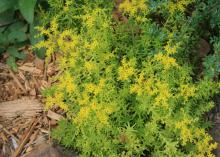Information Possibly Outdated
The information presented on this page was originally released on February 5, 2018. It may not be outdated, but please search our site for more current information. If you plan to quote or reference this information in a publication, please check with the Extension specialist or author before proceeding.
Succulent lemon sedum thrive in sunny locations
As we're working our way through this year's Mississippi Medallion Winners, I now want to look at Sedum rupestre, which is commonly called lemon sedum. The sedums are also called stonecrop, because they are native to the mountainous regions of central and western Europe.
The native species have cylindrical, succulent foliage in various shades of grayish-green. But the new selections called lemon sedum have yellow to chartreuse foliage. I really like how the foliage has tinges of rusty red and orange in the cooler winter air.
Of the several selections called lemon sedum, some are strictly annual, while others are perennial in coastal counties. Here are a few to look for this year.
Lemon Coral is a great selection, with bright, chartreuse foliage that really shines when grown in at least filtered sun. Full sun is best.
The spiky, succulent foliage spreads 12 to 24 inches, requiring a space of 16 to 24 inches to properly grow. It reaches an optimal height of 3 to 6 inches. The mounding growth habit makes it a perfect filler plant in a combination container. This plant pairs well with other sun-loving container plants.
Lemon Ball is another fantastic choice. This selection has soft, succulent foliage and is perhaps the most heat tolerant of the Lemon sedums. This characteristic makes it ideal for our intense summer conditions. Lemon Ball grows only about 6 inches tall, but it can reach about 3 feet wide where it is perennial.
Angelina is an older selection but still one of the best sedums for foliage use. The brilliant yellow-chartreuse coloration adds a much-needed cheery color wherever it's planted.
Lemon sedums are easy to care for and tolerant of moderate drought conditions. My favorite growing style is in containers, and I always make sure the root zone is consistently moist. Feed with water-soluble fertilizer on a monthly basis to keep the plants growing and in best condition.
Lemon sedum is a real treat when it blooms, displaying flat-topped groupings of yellow flowers.
Later in the summer, the center of the plant may open up, so don't be afraid to prune it back to tidy it up. This pruning will promote more lateral growth and a bushier, fuller plant for the fall. Lemon sedums have no serious pests or diseases to worry about.
For the adventurous Southern gardener, lemon sedum would make a great choice for a rock garden on a small, sunny slope. Make sure the bed is well drained. I imagine a crevice garden, which is currently a hot gardening trend, would be a good growing location.
An easy-to-grow plant like lemon sedum will make your garden and landscape a winner in 2018.








